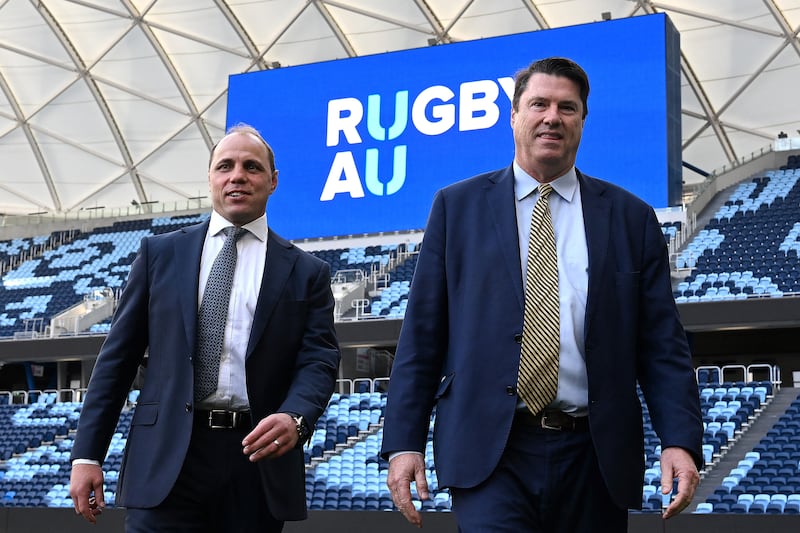On Saturday afternoon (4.05pm Irish time) the Wallabies will walk on to Loftus Versfeld in the full knowledge that Australia have never beaten the Springboks in Pretoria. The South Africans are red-hot favourites.
Yet the Wallabies are playing for far more than a historic win. They are taking their first tentative step in a long-term strategic plan aimed at reviving the game in Australia.
The prematch discussion has been dominated by the return of Eddie Jones as head coach. Since his surprise appointment earlier this year Rugby Australia (RA) has launched Jones on a national media charm offensive.
A bit like Donald Trump on a presidential campaign, Eddie has been on the hustings, going on talkshows, podcasts, news broadcasts and visiting schools and clubs. It is possible that opening new hospital wings, kissing babies and appearing at dog shows is on his future schedule.
The unwritten theme of the campaign is Make The Wallabies Great Again. MTWGA does not roll from the tongue like Maga, so no loud red caps have appeared ... so far.
Before Jones’s appointment, the profile of rugby in Australia has sunk lower than a hiding red-bellied black snake. A huge factor in his appointment is to use his persona to re-establish rugby’s profile in the highly competitive Australian sports market.
That mission that could have the working title Operation Lazarus because, after two decades of shocking leadership, rugby was all but dead in Oz.
Those of us who love the game in Australia have been forced to witness 20 years of catastrophic decision-making by a long line of administrative leaders seemingly bereft of understanding of high-performance, community and pathway rugby. This has resulted in a rapid decline in participation numbers in the grassroots of the men’s 15-a-side game in Sydney.
In a series of acts of self sabotage, the leadership actively destroyed the production line that had provided generations of creative players. Last week’s demolition of the Junior Wallabies by the Irish under-20s is proof that RA has not yet attacked these systemic problems with the right tools.
In Pretoria for this week’s Test, Australia have selected Nick White, Quade Cooper and Reece Hodge at 9, 10 and 12. All are in their 30s and well past their prime. They are selected because the talent pool below them is close to empty.
After the 2003 Rugby World Cup, Australia’s unique way of playing the game was abandoned by successive RA leaderships. With the notable exception of Michael Cheika, many local coaches were pushed aside and a string of Kiwis were appointed to high-performance coaching roles. RA seemed determined to become New Zealand’s third island.
Under the law of unintended consequences, these horrific decisions from past administrations tossed aside decades of intergenerational coaching knowledge and wisdom that has not been passed on to today’s young coaches.
As Australia’s performances declined, so did match revenues, bums on seats, TV audiences and kids lacing up boots.
When the pandemic hit, RA was so critically weak that survival was touch-and-go. The decline from world champions in 1999 to collapse was more than dramatic, it was tragic.
To survive and to be reinvigorated, RA needed a few very tough leaders. Not on the field but in the boardroom.

As soon as Hamish McLennan was appointed as the new chairman of RA, it was clear that he was taking no prisoners.
From standing up to the Kiwis regarding Super Rugby, to a public name-calling fest with the Australian Rugby League’s chairman, McLennan was up for every fight required to revive Australian rugby. And more power to him.
Besides recruiting Jones, McLennan has made two other brilliant and brave appointments. Former Waratah and Wallaby great Phil Kearns was appointed as chairman of the Australian bid for the men’s and women’s Rugby World Cups. Winning the right to host both the men’s in 2027 and women’s in 2029 will see RA back to a position of financial strength for the first time since 2003.
McLennan also recently appointed Phil Waugh, another former Waratah and Wallaby, as chief executive of RA. Waugh is the first chief executive to have developed through Sydney’s juniors, schools, clubs, province and national structures. At long last, RA has leaders with intimate knowledge of the game’s structures in Oz.
At a recent MTWGA rally, stalking his podium, microphone in hand, Jones called for Australian coaches to play unstructured rugby and let the players make spontaneous decisions in general play. Like calling for a wall to be built across the US-Mexican border, that deeply appeals to certain sections of the Australian rugby constituency.
The practicalities of such a policy are far more detailed and difficult to implement, but hey, it sounds great.
Will Jones, who in the past has coached the most highly-structured game plans imaginable, do the unimaginable and say to his Wallaby team in Pretoria, “Bugger it. Go out and have fun against those giant Springboks. Do whatever comes into your sweet little heads.”?
I don’t think so.
While an unlikely Wallaby victory would inject huge energy into McLennan’s plans, in the bigger scheme of things the result of the match is not hugely important because it is only the first step of literally hundreds that are required at multiple levels to revive Australian rugby.
While the Wallaby performances are the symptoms, the true illness sits in the structures and coaching below the national team. The solution to these problems will require great wisdom across a very long time frame.
The good news for Australian rugby is that it now has a chairman, chief executive, World Cup chief and head coach who understand Australian rugby and its deep troubles.
That is a major leap forward towards solving the entrenched systemic problems that have dragged the Wallabies down from their once glorious pinnacle.






